Historic Numbers of Monarchs Seek Shelter at Roost Sites in the Lake Erie Region
Wednesday, September 18th, 2019 at 2:42 pm by Jim LovettFiled under Monarch Migration | Comments Off on Historic Numbers of Monarchs Seek Shelter at Roost Sites in the Lake Erie Region
Republished with permission of the Southern Lepidopterists Society
by Candy Sarikonda
The monarch fallout which occurred during the weekend of September 7-10, 2018 was truly of historic proportion. Thousands of monarchs were reported roosting at numerous sites from Toronto to Chicago, with countless monarchs sheltering from a powerful storm at roost sites in the Lake Erie islands and along Ohio’s Lake Erie shoreline. This once-in-a-lifetime event triggered by remnants of Tropical Storm Gordon sent monarch enthusiasts squealing with delight on social media. The Nor’easter swept through the Lake Erie region during peak fall migration for the monarchs, and sent the monarchs dropping from the sky to seek shelter from the powerful winds and rain that swept through the region.
I raise monarchs from wild eggs I have collected in my northwest Ohio garden. This allows me to be better able to predict the timing and size of the fall migration in my area, based on when my wild-collected monarchs begin to eclose in September. The first week of September 2018 my wild monarchs were eclosing, and I knew peak migration was moving through my area. I carefully watched the weather, and noted the remnants of Tropical Storm Gordon moving through the Lake Erie region. I had also noted reports of large numbers of monarchs being sighted much of the summer and I knew this combination of peak migration, large population size and storm activity had the potential to create large monarch roosts at favored sites in and along Lake Erie. But nothing could have prepared me for just how spectacular this migratory event would be.
I journeyed to South Bass Island in Lake Erie with my mother and children to document the anticipated monarch roosts. We arrived at Catawba Point the afternoon of Friday, September 7th and were stunned to learn that the Nor’easter had already moved in quite fiercely, to the point that the Miller Ferry boat captains were warning passengers that they would likely be cancelling ferry service for Saturday evening and Sunday, due to 10 foot waves on Lake Erie and the storm surge created by the powerful winds. We sought the advice of friends on the island, and decided to still make the journey to South Bass Island, just 3 miles off shore. We had to leave our car on the mainland, and journeyed over to South Bass Island as foot passengers on the ferry.
We arrived on the island and my friend DJ Parker gave us his electric golf cart to use. We headed to our favorite chocolate shop and the downtown area for some lobster bisque. As we ate, I noticed only about a half dozen boats in the harbor, the place seemed empty. VERY unusual for a Friday night, and a bit concerning. I checked the radar, and noted rain was headed our way. So we finished eating and headed back to DJ’s to spend the night
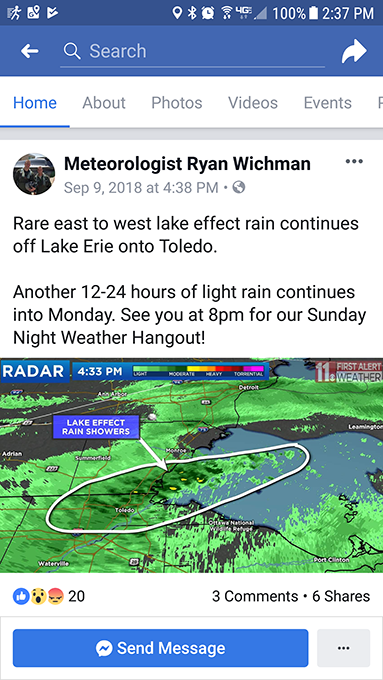
Screenshot of meterorologist Ryan Wichman’s facebook page during storm (Photo by Candy)
My gut instinct told me the monarchs would be at the lighthouse grounds on the southernmost tip of the island. But I did not want to risk my family getting caught in the rain. So my family stayed at DJ’s, and I headed to the lighthouse grounds alone
As I reached the sunflower field next to the lighthouse grounds, I scanned it for monarchs. I saw 4 monarchs still feeding. It was getting a little dark due to sunset and the approaching storm. I knew the monarchs should be roosting, but I did not see any flying toward the usual spot in the trees next to the sunflower field.
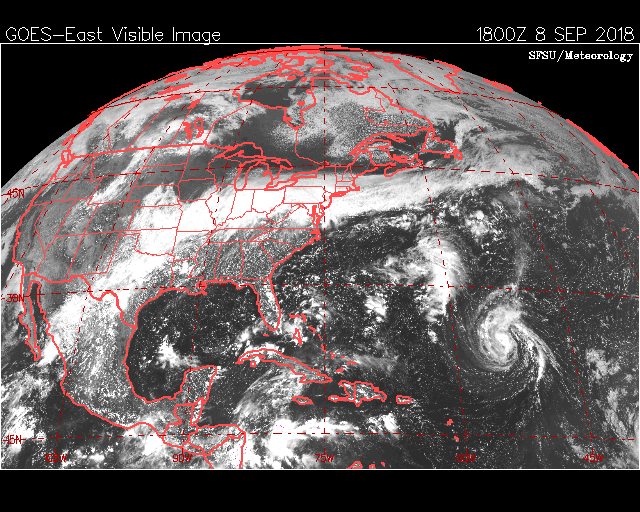
CA Regional Weather Server at SFSU 8-IX-2018 satellite image of Gordon
I headed to the adjacent lighthouse grounds, parked, and stood in the driveway watching for monarchs that were flying toward the line of trees. Nothing was happening near the sunflower field. But out of the corner of my eye, through a gap in the trees, I saw 2 monarchs hovering around the other side of the trees (on the lighthouse side). They flitted along the trees, clearly looking for a roosting spot, and I followed them. They flew further down along the trees, I pursued them, and as I rounded the tree line I was greeted with hackberry and maple trees filled with clusters.
I found 1000 monarchs taking refuge at this location on the leeward side of the trees at the South Bass Island lighthouse grounds. This is the largest number I have documented at this site in 5 years, and I have never seen them roost in this particular location on the lighthouse grounds. But it was a perfect location, warm and sheltered from the sustained 20-30 mph NNE winds which were still increasing. I messaged my friend, Darlene Burgess, who does the monarch counts at Point Pelee National Park. She reported 10,000 monarchs were roosting at the tip of Point Pelee. We were excited.
I continued to observe the monarchs before me. The stable flies were biting me like crazy. I could barely stand to take pictures of the roosts.
The things one does to document monarchs.
Determined, I texted Jackie Taylor of the Lake Erie Islands Nature and Wildlife Center, and she joined me at the roosts. Her partner is a ferry boat captain, and she warned me that the ferrymen were now saying they would likely stop ferry service after just a few runs in the morning. I needed to leave the island with my family first thing in the morning, or be forced to stay until Monday.
All night I listened to the winds as my children slept.
We got up early the next morning, ate a quick breakfast, and went with DJ to the lighthouse grounds. As expected, the monarchs were still roosting just after sunrise. A few dozen monarchs would erupt from clusters in bursts to the delight of my family, but then quickly returned to the clusters.
We enjoyed them for a bit, but alas we knew we had to leave. Time was running out to get home safely…
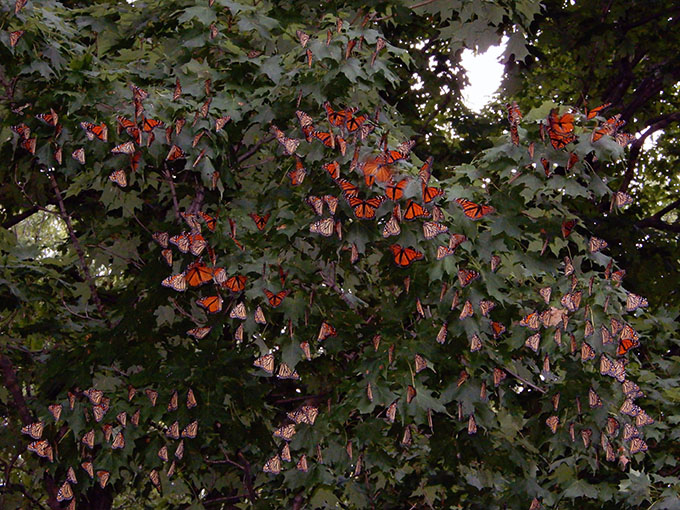
September 8, 2018, South Bass Island monarchs roosting in maple tree (Photo by Candy)
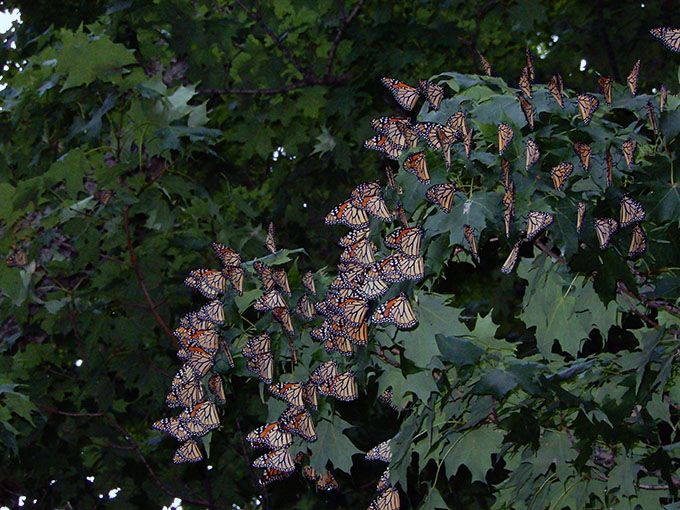
September 7, 2018, South Bass Island, monarchs roosting in maple tree (Photo by Candy)
We arrived home, and I watched the roost reports pour in on Journey North and social media throughout the day on September 8th. DJ Parker texted me to say he had a roost of 100 monarchs for the first time ever, in the trees next to his ice cream shop’s garden near downtown Put-in-Bay on South Bass Island. Another observer on the island reported seeing 100 monarchs in a roost near Park Hotel adjacent to the downtown park. Researchers with Pelee Island Bird Observatory reported on their Facebook page that they were seeing “innumerable monarchs” on Pelee Island’s West Beach beginning 9-9-18, ultimately staying 3 days to ride out the strong winds before leaving their roosts to fly out over Lake Erie. Several observers at Wendy Park, on the Lake Erie shoreline near downtown Cleveland, OH also reported seeing 1000 monarchs roosting in the trees along the leeward side of the main woodlot and other areas of the park, remaining there through September 9th.

September 7, 2018, South Bass Island, monarchs cluster in maple tree (Photo by Candy)
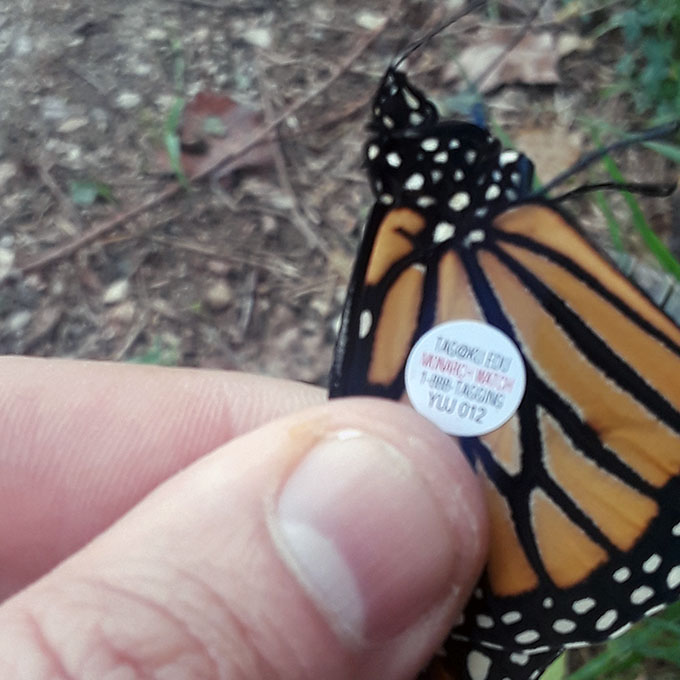
Tagged monarch YUJ012 by Patrick Hogan
September 9th also saw several more reports. Steve Altic on Kelleys Island in Lake Erie reported seeing 200 monarchs at the southernmost tip of the island, roosting in a birch tree about 50 feet from the water’s edge to escape the 25mph winds. A second observer, Bryan Plonski, reported seeing at least 500 monarchs roosting on Kelleys Island from 9-9-18 to 9-10-18, on the west side of trees away from the strong NNE winds. He was delighted, reporting that he had never seen so many butterflies roosting at this site before. The Lake Erie Islands Conservancy reported on Facebook on September 9th, noting monarchs were taking refuge in several island preserves. “Large concentrations of monarchs were found in large trees out of the wind” near Lake Erie on 9-8-18 and 9-9-18, including at Scheeff East Point Preserve and Massie Cliffside Preserve on South Bass Island in Lake Erie and at Middle Bass East Point Preserve on Middle Bass Island in Lake Erie. Video and images of the roosts were posted to their Facebook page on September 9th.
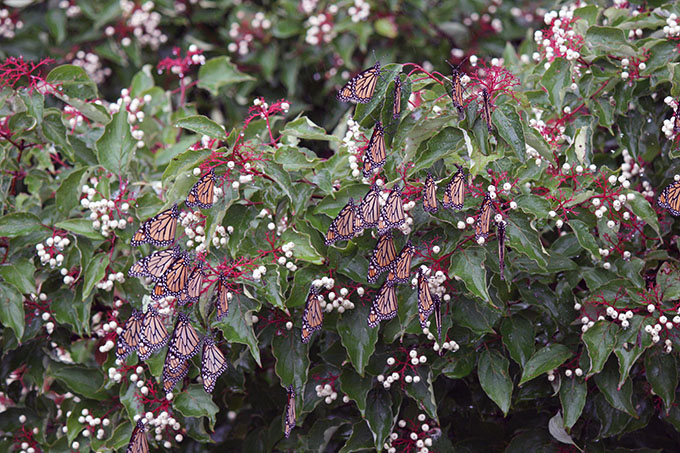
September 10, 2018, Monarchs cluster in dogwood at Ottawa National Wildlife Refuge (Photo by Candy)
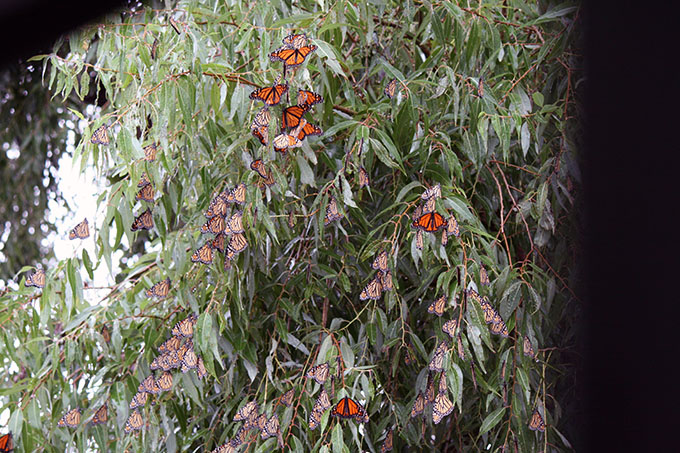
September 10, 2018, Monarch cluster in willow at Ottawa National Wildlife Refuge (Photo by Candy)
Reports continued along Ohio’s shoreline. Nothing was more spectacular than the monarch fallout that occurred at Ottawa National Wildlife Refuge in Oak Harbor, Ohio, along the Lake Erie shoreline beginning on 9-8-18.
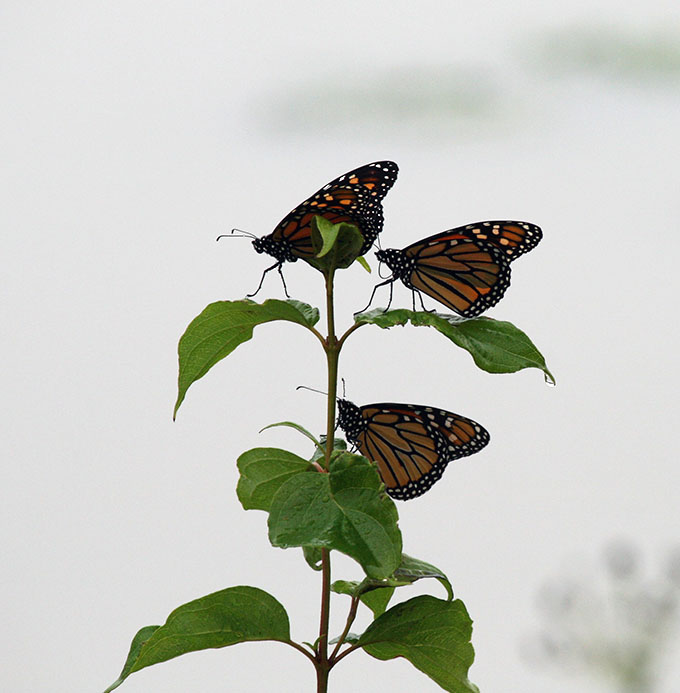
September 10, 2018, Monarch sips water from its body at Ottawa National Wildlife Refuge (photo by Candy)
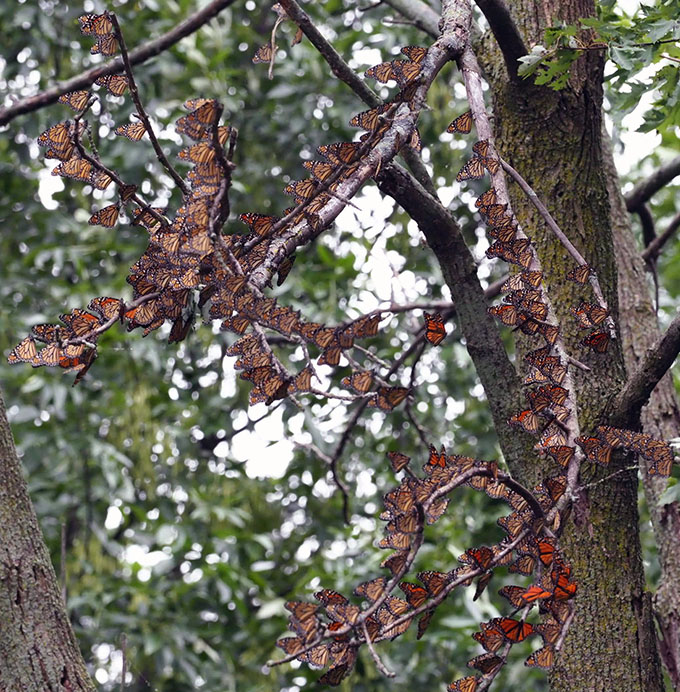
Monarchs lined up on the leeward side at Ottawa National Wildlife Refuge (Photo by Jackie Riley)
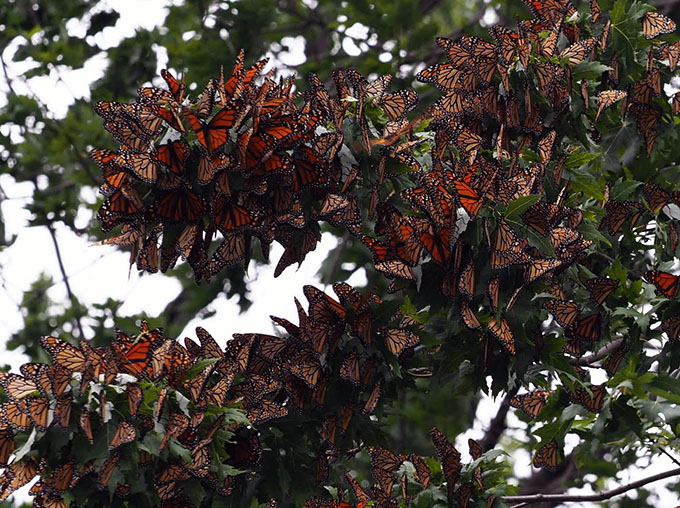
Roost sizes increased as we neared Lake Erie (Ottawa National Wildlife Refuge) (Photo by Jackie Riley)
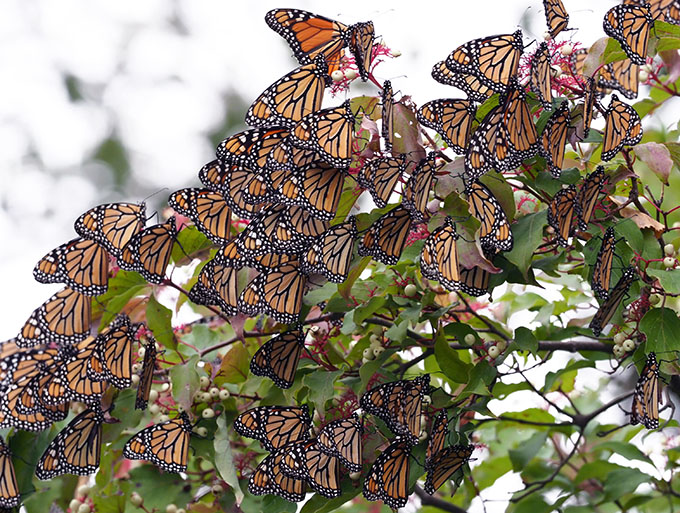
Small portion of one of over 70 roosts along a 6 mile trek (Ottawa National Wildlife Refuge) (Photo by Jackie Riley)
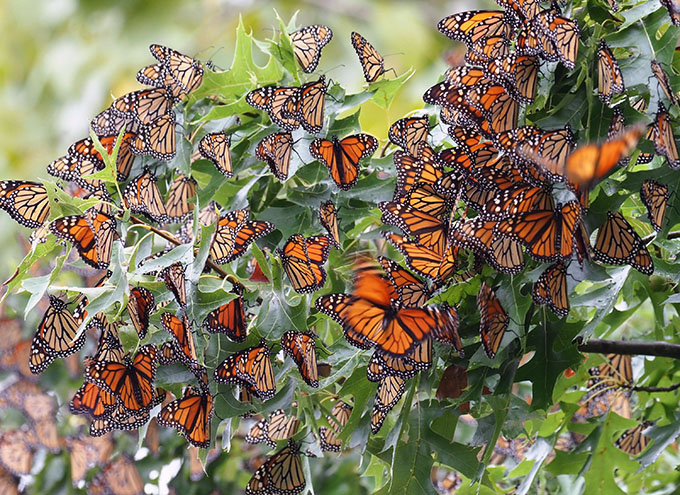
Struggling to gain a foothold in the winds (Ottawa National Wildlife Refuge) (Photo by Jackie Riley)
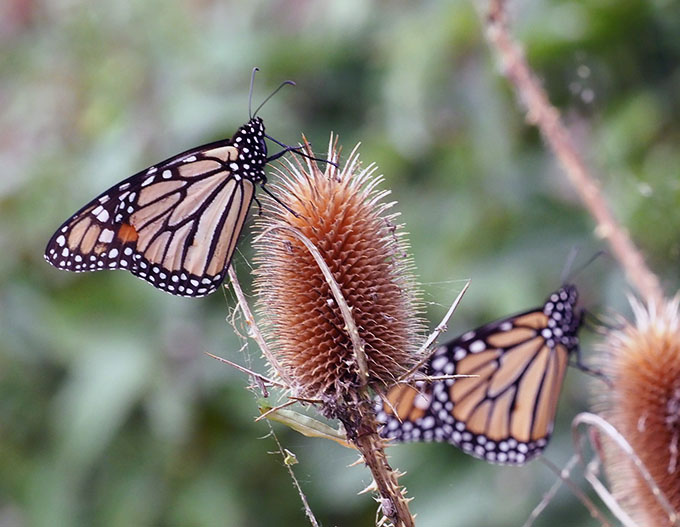
Holding steady on the nearest plant (Ottawa National Wildlife Refuge) (Photo by Jackie Riley)
Refuge staff reported conducting a monarch count from 7-9:30am on 9-9-18, during which they counted 30,000 monarchs roosting in trees along the roads on the park’s Wildlife Drive. Staff reported, “We are experiencing the remnants of Gordon, so we have strong wind pushing off of Lake Erie (16-20mph) creating a Nor’easter. The water levels are pretty high from a combination of rainfall and lake levels over the past 20 hours. Temps are about 60 degrees F with high humidity. The monarchs are roosting on the western side of the trees out of the wind as much as they can be, but they are still bouncing around like crazy. There are pockets of them low in willows and dogwood, but even more towards the tops of cottonwood and maple trees. They were packed in there so tightly that in spots we thought that the leaves had started to change until we had a closer look! There are also monarchs moving over the marshes in the hundreds…Every tree had monarchs on it, from South Estuary Avenue thru North Estuary Avenue and parts of Veler Road and Trumpeter Trail, and a small section of Stange Road. Absolutely incredible.”
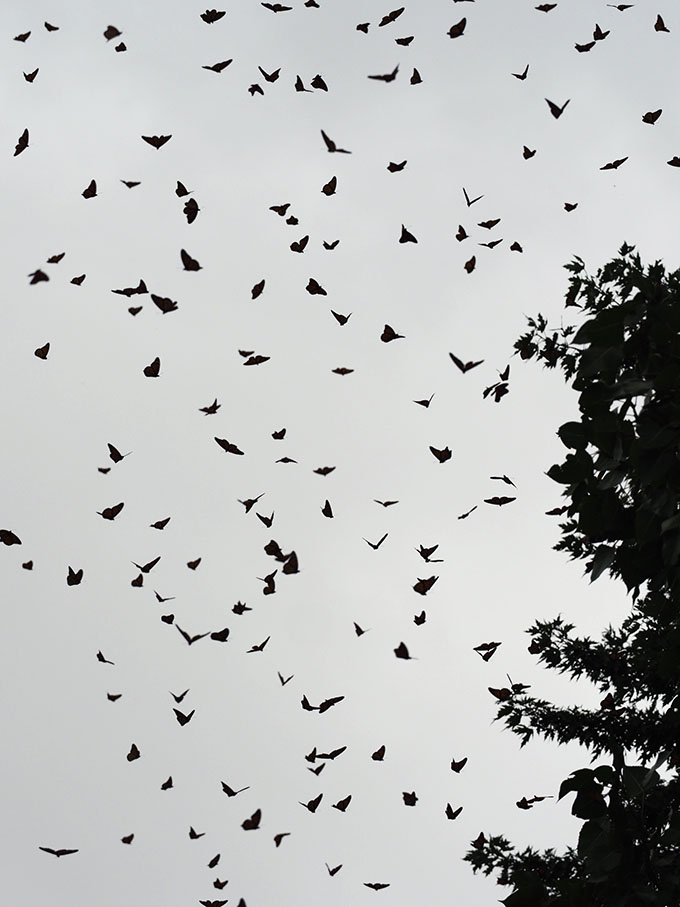
Massive roost with many in motion at Ottawa National Wildlife Refuge (Photo by Jackie Riley)
Jackie W. Riley of the Ohio Lepidopterists Society also reported from Ottawa National Wildlife Refuge later that same day (9-9-18). Riley reported viewing monarchs from 2-4:15 pm at the refuge, and at first estimated seeing approximately 2 million monarchs. She later revised her estimate to 200,000 after counting monarchs from over 400 photos she had taken during that 2 hours. Her photos were instrumental in documenting the magnitude of the event. This was truly a remarkable fallout of monarchs, nothing close to this has been seen since 96,000 monarchs were recorded at Point Pelee on September 6, 1993, including two overnight roosts of 7,500 and 3,000 individuals (cited in Wormington, A. 1994. A mass migration of Monarchs at Point Pelee, Ontario. pp. 26-27. In Hanks, A. J. (ed.), Butterflies of Ontario and summaries of Lepidoptera encountered in Ontario in 1993. Toronto Entomologists Association Occasional Publications 27-95.)
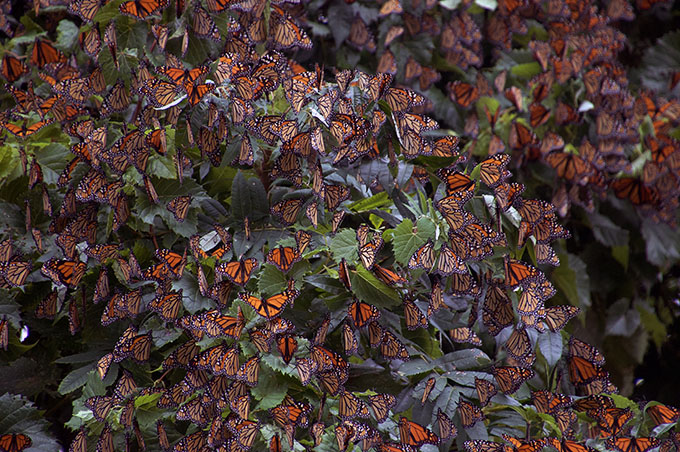
Monarchs roosting in Ottawa National Wildlife Refuge (Photo by Douglas Brockway)
Riley reported, “There were many independent roosts, but outstanding were the wooded stretches along the dike roads that held mega roosts with strands of smaller roosts that continued for many yards. Six different dike roads were involved. I was at the refuge the day before (Saturday 9/8/19), and saw NO roosts. However, there were reports of some smaller ones. So, in 24 hours, the roosts went from some, (I think it read a count of 1,000 individuals or more) to the exponential numbers that I saw.”
Riley further stated, “I would guess there were 50 roosts (several dozen). I stopped counting the roosts after the first 12 and figured I was less than one-third the way through the refuge auto-tour. The bulk of the roosts were further north which was the last two-thirds of the tour. Roosts were spread out and thin for the first one-fourth to one-third of the tour…The massive roosts were at one point 100 feet off the lakeshore that had pounding waves and 35mph+ sustained winds. All the monarchs were on the leeward side of the woods that sat between the road and the shoreline. A perfect scenario for them to find shelter immediately coming in off the lake. Weather notes for 9/9/2018: 2 pm-4:15 pm is when I saw them. 63F, 100% sky cover, raining at 4:15pm. Winds over the lake were at least NE 35mph sustained. Winds inside the refuge ranged from NE 10-25 mph depending on location. I believe the overnight temps were in the mid-high 50Fs with rain in the a.m. through 12pm.” Riley noted there were fields of sunflowers and a small amount of goldenrod available for nectaring along the Wildlife Drive.
Notably, Patrick Hogan of Tomahawk Archers and Douglas Brockway of Ottawa National Wildlife Refuge (ONWR) both separately found a tagged monarch at ONWR during the weekend storm. The monarch was tagged with the code YUJ012 and was originally tagged 4 days earlier in Waterford, PA on 9-5-18. This monarch’s likely southwest trajectory along Lake Erie’s southern shoreline, unexpectedly moving west to northwest in the last leg of its flightpath, was likely due to the strong NNE winds moving through the region as Tropical Storm Gordon remnants moved through the area. Doug stated, “I have been coming to ONWR for over 60 years, and never before in my lifetime have I seen this many monarchs.”
By September 10th, the Nor’easter was moving out of the Lake Erie region. The sun emerged and it quickly began to warm up. I had been unable to visit Ottawa National Wildlife Refuge on 9-9-18, but I rushed to the refuge early in the morning on the 10th. It was still rainy and a little cool when I arrived, and the rangers kindly arranged to shuttle visitors out to the monarchs. It continued to warm up as we waited for the shuttle, with light winds around 8-10 mph at times. We left at 10:30am, and air temperatures were 58-62F at that time. Clearly, these temperatures were above flight threshold. As a result, most of the monarchs were gone by the time we reached the roosting sites, with only around 1000 monarchs left, scattered along South Estuary drive. I captured a few dozen photos and it was wonderful enjoying the company of fellow monarch enthusiasts, despite the near constant drizzle. I figured the monarchs would head for fields with large numbers of wildflowers to feed (nectar source). I later found some monarchs in the meadows surrounding the nature center, and a small roost was forming in the line of cottonwood trees across from the barn. But it was clear—the improving weather meant the monarchs would now resume their journey south. Subsequent posts on Journey North and social media indicated the roosts were breaking up throughout the region, and our adventure was over.
The weekend’s historic monarch migratory event was truly a once-in-a-lifetime experience, resulting in cherished memories for years to come. Remarkable. Unforgettable. Historic.
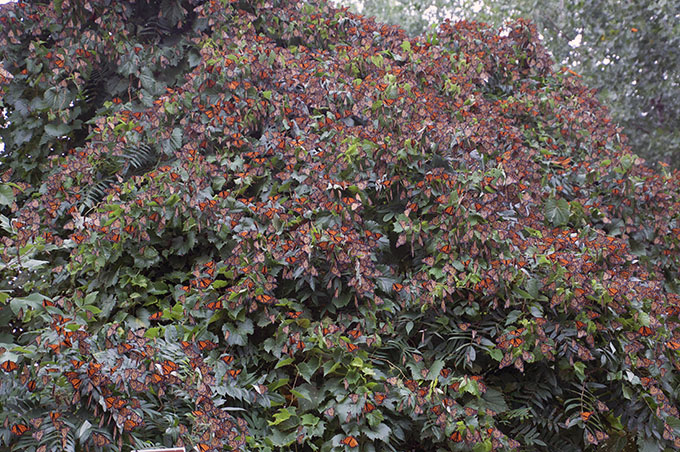
Monarchs roosting in Ottawa National Wildlife Refuge (Photo by Douglas Brockway)
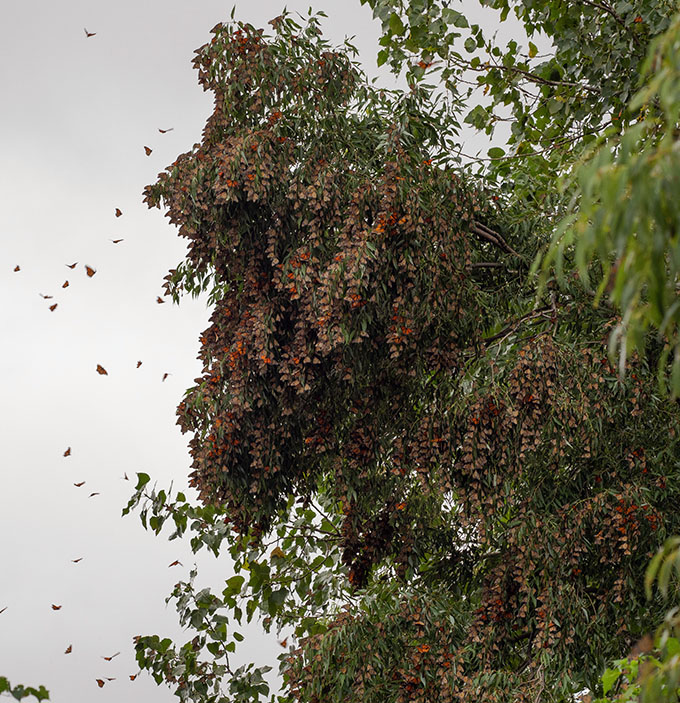
One of the largest roosts observed at the Ottawa National Wildlife Refuge (Photo by Jackie Riley)
Additional photos:
flickr.com/photos/candy__kasey/albums/72157700912789324


Sorry, comments for this entry are closed at this time.